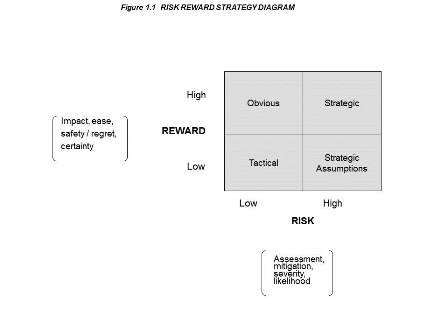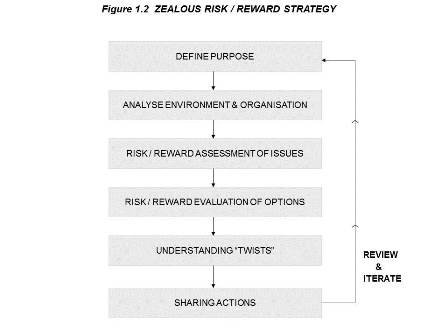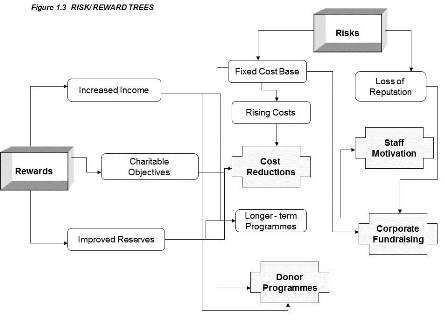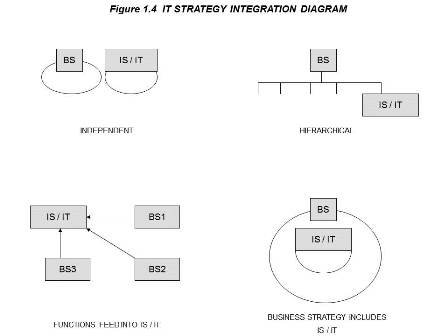Chapter 1: What and Why
IT Strategy - Using this Part of the Book
This is probably the most narrative part of the book although it also contains plenty of practical tips and techniques for producing an IT strategy for your organisation. For example, 'Needs, wants and prioritisatoin' contains tools for determining information needs and prioritising your ideas and the COD-VERB table in 'Governance' provides a useful checklist to ensure that you are getting value from your use of IT.
If you are interested in larger not-for-profit organisations or a student of management, you will probably find the whole part useful and pertinent.If you are interested in smaller and medium-sized not-for-profit organisations, you will probably benefit from reading chapter 'IT Strategy: What and Why' for context and using chapters 'Needs, Wants and Prioritisation' and the first part of 'Governance' as practical guides to formulating your IT strategy. You will also get some thoughts and ideas from skimming the second part of 'Governance' and 'Knowledge Management'.
1. IT Strategy: What and Why
Chapter objectives
In this chapter we shall:
- Define strategy and IT strategy.
- Discuss the relationship between organisational strategy and IT strategy.
- explain why IT strategy is important to all organisations.
What is strategy?
The word "strategy" comes from a Greek word, strategos, which means a military general. Early strategies were generals' plans and it can be a little unnerving in the not-for-profit sector to indulge in an activity which so obviously originated for military purposes. However, organisational strategy has moved on from the military style. It has also, thankfully, mostly moved on from the rah-rah approach of hollow vision and mission statements designed to rally the workforce. A strategy can be defined as an 'integrated set of actions to achieve sustainable competitive advantage'. Whereas in the past strategy has often been seen as synonymous with long range planning as opposed to short term planning, today we tend to look at strategy as the means of making high-risk, high-reward decisions rather than day-to-day decisions.
The diagram below illustrates four different types of decision, only one of which is strategic:
- Low risk, low reward decisions are tactical.
- High risk, low reward decisions are about strategic assumptions (e.g. risk management).

- Low risk, high reward decisions are obvious.
- High risk, high reward decisions are strategic.
How does one strategise?
Strategy could be the subject of a book such as this book in its own right. We present below an illustration of a typical risk/reward approach to strategy, here using the Z/Ealous risk/reward methodology for a quasi-government, not-for-profit client. For a large organisation, such an exercise can be many weeks of work. Smaller organisations can achieve excellent results following the same approach in a handful of thoughtful sessions.

The Phases
- Environment phase: the team confirmed its objectives, the organisation's mission, goals, values and beliefs e.g. public sector values, private sector involvement. It also developed some generic risk/reward `trees' (cascading sets of risk/reward structures) from research on similar organisations.
- Analysis phase: a variety of strategic planning tools, e.g. Porter's five forces, BCG models and factor analysis, were used to find the risk/reward issues which affected the organisation achieving its mission. All issues were valid, even though later ranking of severity and likelihoods might diminish the importance of some. A unique risk/reward tree was built for the organisation (see figure 1.3), with political risk as the root risk and meeting charitable objectives was the root reward.
- Likelihoods (risk/reward):forty to fifty major issues were categorised as risks or rewards. Risk/reward issues were also reversed (risks became rewards and vice versa) to determine the full shape of the possible outcomes, as perceived by senior managers. Taking the final set of issues and their possible outcomes, a Monte Carlo simulation was run, combining the risks and rewards with their severities and likelihoods, identifying those which had the greatest impact on the organisation either achieving or failing in its goals.
- Options: for each issue, a variety of actions were developed, and a variety of actions, that senior managers hoped to achieve, e.g. Investors in People, were correlated, if possible, with risk/reward issues. Options were ranked on categories such as impact, certainty, safety/regret and ease.
- Uniqueness: both the risk/reward issues and the options for addressing them were then subjected to finding the 'twist', i.e. a way of succinctly expressing the issues and options which revealed their underlying essence. The 'issues twist' was a short tale describing the scenario of the organisation. The 'options twist' was an easily remembered five-point strategy subsuming almost a hundred separate actions.
- Sharing: the issues were shared with the organisation and its stakeholders. The actions were partially re-discovered, partially re-worked with the stakeholders, including more junior management. The strategy was implemented as both a hard system, i.e. corporate plan and objectives, and a soft system, i.e. culture change to achieve greater unity in both risk/reward beliefs and their priorities. Results, both successes and failures, were tracked and fed into the subsequent year's planning cycle.
A possible risk/reward tree for a not-for-profit organisation is illustrated below.

The important point is that any strategy, be it an organisational one, a reserves strategy or an IT strategy, can follow the above basic process to good effect and that phases can be repeated as needed.
Further, there is a relationship between IT strategy and organisational strategy. How IT strategy relates to an organisation's strategy can be a matter of debate and is discussed further in the section below.
What is an IT strategy?
IT strategy can be defined as 'the alignment of an organisation's goals with the planned use of IT within the organisation'. The processes of an IT strategy can be summarised as the following:
- Understanding the organisation and its objectives
- Identifying information needs (separating needs from wants).
- Prioritising IT opportunities within the constraints of your available resources.
The challenges for not-for-profit organisations in tackling these processes successfully are discussed in the next chapter.
It might seem arcane to discuss the relationship between organisational and IT strategy at some length, but it is in fact important. If you have not worked out how you are planning to align your organisation's use of IT with its goals, you don't really know where to begin planning your use of IT. We believe that there are essentially four main ways in which an organisation can relate its business (organisational) strategy to its IT strategy:
- Independent. Organisational strategy and IT strategy are developed independently of one another and subsequently aligned.
- Hierarchical. The IT strategy is one of several 'departmental' strategies subservient to the organisational strategy. Such an IT strategy would be established after (and as a result of) an organisational strategy.
- Subset. The IT strategy is an intrinsic subset of the organisational strategy. Such an IT strategy would probably be formulated iteratively along with the organisational strategy;
- Multi-functions. Several IT strategies co-exist - each of the organisations business functions has its own IT strategy. Such a collection of strategies would probably be developed individually and quite possibly in an uncoordinated manner.
The diagram below illustrates the four main ways described above.

Several years ago we conducted a survey of several hundred organisations, mostly commercial, some governmental, some voluntary sector. We asked (amongst other things) about the nature of the relationship between IT strategy and organisational strategy. In our recent survey of the voluntary sector we asked this question again. The results from those who responded to the question are shown in the table below.
Table 1.1 IT Strategy Types Survey Results
| IT Strategy Type | All sector survey early 90's %age of respondees | Recent voluntary sector survey %age of respondees |
|---|---|---|
| Independent | 6% | 5% |
| Hierarchical | 42% | 25% |
| Subset | 40% | 65% |
| Multi-functions | 12% | 5% |
We do not believe that there are right and wrong answers to this question, as different organisations have different structures and needs. We find it unlikely that many organisations would benefit from undertaking IT strategy in isolation from organisational strategy (type 1), but the other three types of relationship can be effective in the right circumstances. Where not-for profit organisations often err is by being too quick to adopt a multi-function (type 4) approach to IT strategy on the basis (for example) that fundraising is a fundamentally different activity from service provision or grant making. Most not-for-profit organisations would benefit more from a single IT strategy which brings together common IT needs and themes. This approach helps an organisation to improve its sharing of information across its diverse functions, making hierarchical (type 2) or subset (type 3) style IT strategies more helpful candidates for not-for-profit organisations.
Why should anyone bother with IT strategy?
At one level, IT strategy is easy. We can write a form of IT strategy for your organisation without even meeting you. So why bother to devise your own?
At a more realistic level, IT strategy is difficult and can be especially hard for not-for-profit organisations. We tend to describe IT strategy as 'the slightly scientific art of exploring IT aspirations and containing them within pragmatic, prioritised plans for using IT to support your not-for-profit organisation’s business strategy'. The output should be an integrated and achievable set of actions. Not-for-profit organisations often have high aspirations and very limited means to fulfill those aspirations. Common resource constraints in not-for-profits (not enough money, not enough people, cannot be seen to be spending too much on technology) are all the more reason to do some IT strategic thinking.
Most not-for-profit organisations are using IT to some extent today. Almost all of those organisations could better support their business strategy simply by applying their existing IT more appropriately to their needs. Often, a small investment in some additional IT can 'get most of the way' to meeting needs, whereas the 'whiz bang' solution that would meet all the needs is beyond the organisations means. All too often, opportunities to 'get most of the way' towards the not-for-profit organisation's aims are wasted due to the futile search for an affordable 'whiz bang' solution. A good IT strategy will retain the vision or aspirations, explore the opportunities available and come up with practical, achievable plans for action which support the organisation’s strategic objectives.
We believe that an organisation should revise its IT strategy whenever it revises its business strategy. IT strategies tend to date within 2 to 3 years, so if strategic planning is irregular in your organisation, consider reviewing your IT strategy in between business strategies. For large not-for-profit organisations (possibly 40 to 50 of the largest UK charities and trusts), the effort involved in IT strategy might be several weeks work. For most not-for-profit organisations, the effort involved is anything from one day to a few days' work. The benefits can often flow quickly and reward the effort many times over.
The Never-ending, Ideal IT Strategy
“Our organisation would like instant access at the touch of just one button (or the bark of a single command) from any location to all of the organisation's own information and any conceivable external information source. All possible elements of the system should be fully integrated. The systems should be available to all but it should be possible to secure information by restricting access at an infinite number of levels. The systems should be 100% stable and completely reliable. All at negligible cost.”
Summary
- A strategy is an integrated set of actions to achieve an organisation's goals.
- Large and small organisations can use a similar approach to producing a strategy - the same basic approach can be used for organisational and IT strategy.
- IT strategy is the alignment of the organisation's use of IT with those goals.
- In most not-for-profit organisations, IT strategy should be devised in conjunction with the organisations strategy or in the aftermath of an organisation's strategic review.
- One of the biggest challenges for not-for-profit organisations is separating IT needs from IT wants in order to prioritise the use of limited resources to achieve strategic goals (see next chapter).
- All not-for-profit organisations should benefit from undertaking IT strategy on a sensible scale at fairly regular intervals (every two to four years).